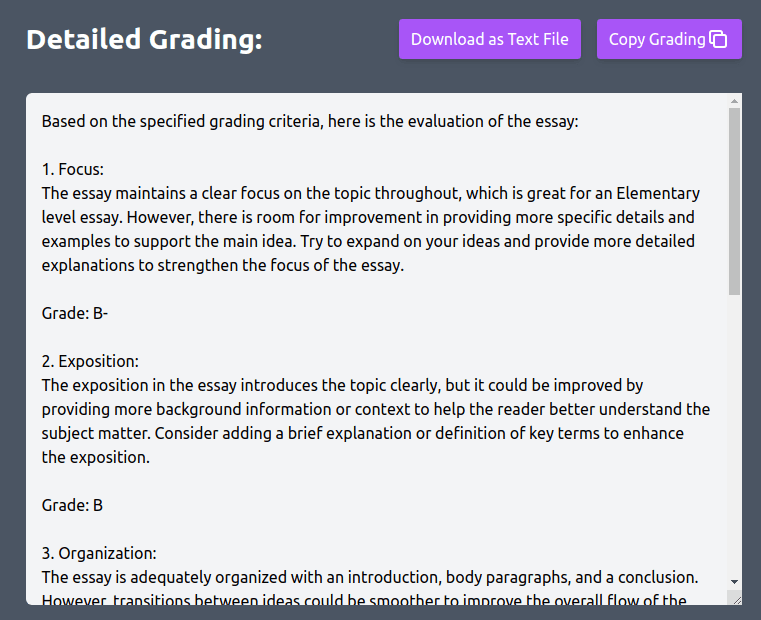
How to grade essays faster: Proven Strategies for English Teachers
Date: 16th July 2024
Grading essays is a critical part of teaching, yet it can be time-consuming and exhausting. Implementing effective strategies can significantly reduce the time spent on this task while maintaining high-quality feedback for students.
Introduction
Grading essays can be daunting, especially with large classes and tight deadlines. However, with the right approach and tools, educators can streamline the grading process, making it more efficient and less stressful. This article explores various strategies and techniques to help English teachers grade essays faster without compromising the quality of their feedback.
1. Develop a Grading Rubric
Importance of a Grading Rubric
As experienced English teachers, you understand the value of a well-defined grading rubric. Rubrics provide clear criteria for assessment, ensuring consistency and fairness in grading. They also help students understand expectations and areas for improvement.
How to Optimize Your Rubric
1. Be Specific: Clearly define criteria such as thesis statement, argument development, evidence, grammar, and style.
2. Use Descriptive Language: Describe performance levels (e.g., Excellent, Good, Fair, Poor) in detail to guide consistent evaluation.
3. Share with Students: Provide the rubric to students beforehand to guide their writing process.

One strategy you can use here is to not leave comments on the paper at all. Just use a detailed rubric, and however you fill it out for them, those are their comments. Similarly, regarding grammar errors, you don't have to point every single one of them. An example of each type of mistake should be helpful enough for a student. Only comment on the first instance of most mistakes.
2. Use Technology to Your Advantage
AI Grading Assistants
One of the most effective ways to speed up the grading process is to use AI-powered grading tools. Tools like EasyMark.ai can help you grade essays up to 10 times faster by automating parts of the evaluation process.
EasyMark.ai
EasyMark.ai is an advanced AI grading assistant that analyzes essays for grammar, syntax, structure, and content. It provides detailed feedback and scores based on your customized rubric. By integrating EasyMark.ai into your grading workflow, you can save significant time and ensure consistent, high-quality feedback.
Other Useful Tools
1. Grammarly: Checks for grammar, punctuation, and style.
2. Turnitin: Offers plagiarism detection and digital grading features.
3. Google Classroom: Provides integrated grading tools and easy sharing of rubrics.

3. Batch Grading
What is Batch Grading?
Batch grading involves assessing common elements of essays in groups. For instance, you might first read through all thesis statements, then move on to body paragraphs.
How to Implement Batch Grading
1. Sort Essays: Group essays based on certain characteristics (e.g., all A-grade potential essays together).
2. Grade One Aspect at a Time: Focus on grading one section (e.g., introductions) across all essays before moving to the next section.
Advantages of Batch Grading
1. Focus: Allows for a more concentrated and consistent evaluation of each aspect.
2. Efficiency: Reduces the cognitive load of switching between different parts of the essays.
4. Provide Timely and Constructive Feedback
Importance of Feedback
Feedback is crucial for student growth. It should be timely, constructive, and specific to guide students in their learning journey.
Strategies for Effective Feedback
1. Use Rubrics: Reference rubric criteria in your feedback to keep it focused and relevant.
2. Be Specific: Highlight specific strengths and areas for improvement.
3. Be Timely: Provide feedback as soon as possible to keep it relevant and useful.
Tools for Providing Feedback
1. Audio Feedback: Tools like Vocaroo allow you to record feedback, which can be faster than writing.
2. Comment Banks: Create a bank of common comments that can be quickly inserted into students’ essays.
5. Time Management Techniques
Set Grading Goals
1. Daily Goals: Set a specific number of essays to grade each day.
2. Time Blocks: Dedicate specific time blocks for grading without distractions.
Prioritize Tasks
1. Start with Easier Tasks: Begin with tasks that require less cognitive effort.
2. Use a Timer: Use the Pomodoro Technique (25 minutes of focused work followed by a 5-minute break) to maintain focus and efficiency.
Avoid Multitasking
Focus on one task at a time to improve efficiency and reduce errors.
6. Use Color-coded highlights
One idea from the community is to use a system of color-coded highlights that signal where you have found an error and what type of error it is. Different colors for issues with word choice, agreement, syntax, and so on. This will require an amount of extra work before hand: explaining it to the students. Go over it together at the start of the semester, but also provide a key to the colors in the rubric. You can combine this with some comments for extra feedback.

7. Encourage Peer Review
Benefits of Peer Review
1. Engagement: Increases student engagement and responsibility.
2. Learning: Students learn by assessing their peers work.
3. Feedback: Provides additional feedback for students.
Implementing Peer Review
1. Training: Teach students how to give constructive feedback.
2. Guidelines: Provide clear guidelines and rubrics for peer review.
3. Monitor: Oversee the process to ensure quality feedback.
Conclusion
Grading essays faster without sacrificing quality is achievable with the right strategies. Developing a clear grading rubric, leveraging technology, batch grading, providing timely feedback, managing your time effectively, and incorporating peer review can transform the grading process. These techniques not only save time but also enhance the learning experience for students.
By implementing these methods, educators can efficiently manage their workload, provide valuable feedback, and foster a more productive learning environment. Remember, the goal is to grade smarter, not harder.
Table of Contents
